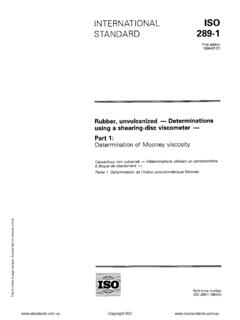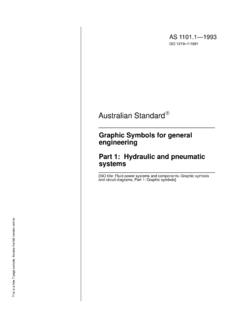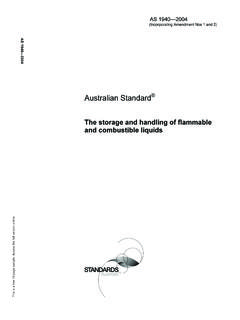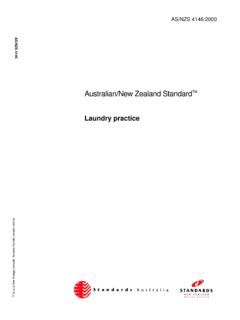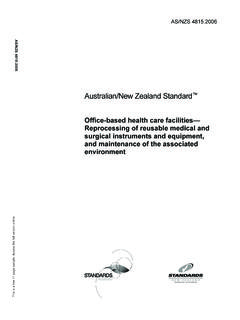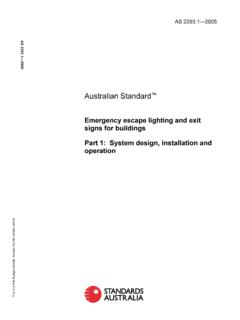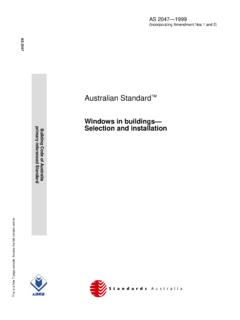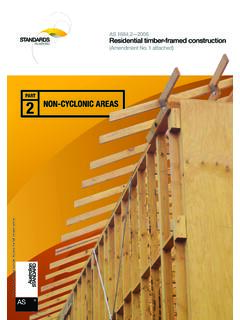Transcription of AS 1170.1-1989 SAA Loading Code - Dead and live loads and ...
1 AS 1989 Australian StandardRSAA Loading CodePart 1: Dead and live loads andload combinationsThis is a free 6 page sample. Access the full version Australian Standard was prepared by Committee BD/6, Loading on Structures. It wasapproved on behalf of the Council of Standards Australia on 26 January 1989 andpublished on 20 March following interests are represented on Committee BD/6: Association of Consulting Engineers, AustraliaAssociation of Consulting Structural Engineers, AustraliaAustralian Clay Brick Association Australian Construction Services (Department of Administrative Services) Australian Council of Local Government Associations Australian Federation of Construction Contractors Australian Institute of Steel Construction Australian Mining Industry Council Building Management Authority, Bureau of Meteorology Bureau of Steel Manufacturers of Australia CSIRO, Division of Building, Construction and Engineering Department of Local Government, QldElectricity Supply Association of AustraliaEngineering and Water Supply Department, James Cook University of North Queensland Master Builders Construction & Housing Association, Australia Monash University National Association of Australian State Road Authorities Public Works Department, University of Melbourne University of NewcastleAdditional interests participating in the preparation of this Standard.
2 Australian Road Research BoardRoad Construction AuthorityUniversity of SydneyReview of Australian Standards. To keep abreast of progress in industry, Australian Standards are subject to peri-odic review and are kept up to date by the issue of amendments or new editions as necessary. It is important there-fore that Standards users ensure that they are in possession of the latest edition, and any amendments details of all Australian Standards and related publications will be found in the Standards Australia Catalogueof Publications; this information is supplemented each month by the magazine The Australian Standard , whichsubscribing members receive, and which gives details of new publications, new editions and amendments, and ofwithdrawn for improvements to Australian Standards, addressed to the head office of Standards Australia, are wel-comed. Notification of any inaccuracy or amibuity found in an Australian Standard should be made without delay inorder that the matter may be investigated and appropriate action Standard was issued in draft form for comment as DR 83229 and 87035 This is a free 6 page sample.
3 Access the full version 1989 Australian StandardRMinimum design loads onstructures (known as the SAAL oading Code)Part 1: Dead and live loads andload combinationsFirst published as part of SAA Int. 350 and redesignated AS and redesignated AS 1969 withdrawn December edition AS edition Amdt1 BY STANDARDS AUSTRALIA(STANDARDS ASSOCIATION OF AUSTRALIA)1 THE CRESCENT, HOMEBUSH, NSW 2140 ISBN 0 7262 5501 7 This is a free 6 page sample. Access the full version 19892 PREFACEThis Standard has been prepared by the Standards Australia Committee for Loading onStructures to supersede AS 1981, Minimum design loads on structures, Part 1:Dead and live loads . This edition is presented in limit states is the first part of the Standard for minimum design loads on structures, whichcomprises the following parts:Part 1: Dead and live loads and load 2:Wind 3:Snow 4:Earthquake loads (not yet published).
4 Explanatory material for this Standard are given in Appendices D to G, which correspondto Sections 2 to edition incorporates the following principal changes:(a) The Standard has been revised in limit states format.(b) A new Section on load combinations has now been included as Section 2.(c) The clauses relating to impact and inertia loads , and braking and horizontal impact incarparks (now Clauses and ) have been expanded.(d) The clause on thermal and movement effects has been revised, taking note of recentwork in this area and included as a new Section 5.(e) In Appendix A, the density and mass of materials are given in terms of kilonewtons forconvenience in design calculations.(f) The lay out of Appendix B is now in the order of different occupancies (as opposed toalphabetical order in the 1981 edition) and all the values of floor live loads have Copyright STANDARDS AUSTRALIAU sers of Standards are reminded that copyright subsists in all Standards Australia publications and software.
5 Except where the Copyright Act allowsand except where provided for below no publications or software produced by Standards Australia may be reproduced, stored in a retrieval system inany form or transmitted by any means without prior permission in writing from Standards Australia. Permission may be conditional on an appropriateroyalty payment. Requests for permission and information on commercial software royalties should be directed to the head office of Australia will permit up to 10 percent of the technical content pages of a Standard to be copied for use exclusively in house bypurchasers of the Standard without payment of a royalty or advice to Standards Australia will also permit the inclusion of its copyright material in computer software programs for no royalty payment providedsuch programs are used exclusively in house by the creators of the should be taken to ensure that material used is from the current edition of the Standard and that it is updated whenever the Standard is amended orrevised.
6 The number and date of the Standard should therefore be clearly use of material in print form or in computer software programs to be used commercially, with or without payment, or in commercial contracts issubject to the payment of a royalty. This policy may be varied by Standards Australia at any is a free 6 page sample. Access the full version AS 1989 COPYRIGHTCONTENTSPageSECTION 1. SCOPE AND GENERAL 4.. DOCUMENTS 4.. 4.. 4.
7 5.. SECTION 2. loads AND load COMBINATIONS FOR STRENGTH, STABILITY AND SERVICEABILITY FOR LIMIT STATES DESIGN AND OTHER ACTIONS 6.. COMBINATIONS FOR STRENGTH LIMIT STATES 6.. LIMIT STATES 6.. COMBINATIONS FOR SERVICEABILITY LIMIT STATES 7 LIMIT STATE 7.. SECTION 3. DEAD loads 8.. FOR PARTITIONS 8.
8 DEAD loads 8.. SECTION 4. LIVE loads 9.. PARTITIONS 9.. Loading 9.. AND INERTIA loads 9.. AND HORIZONTAL IMPACT IN CAR PARKS 9.. , HOIST AND LIFT loads 9.. LIVE loads 9.. AND BALCONY LIVE loads 10.
9 OF UNIFORMLY DISTRIBUTED LIVE loads 10.. INCREASE OF UNIFORMLY DISTRIBUTED LIVE load ON RESTRICTED AREAS 11.. SECTION 5. MOVEMENT EFFECTS 12.. EFFECTS 12.. APPENDICES A UNIT WEIGHTS OF MATERIALS AND CONSTRUCTION 13.. B FLOOR LIVE loads 16.. C LIVE load REDUCTIONS ON BEARING WALLS 21.. D EXPLANATORY MATERIAL TO SECTION 2 23.
10 E EXPLANATORY MATERIAL TO SECTION 3 25.. F EXPLANATORY MATERIAL TO SECTION 4 26.. G EXPLANATORY MATERIAL TO SECTION 5 29.. This is a free 6 page sample. Access the full version 19894 COPYRIGHTSTANDARDS AUSTRALIAA ustralian StandardMinimum design loads on structuresPart 1: Dead and live loads and load combinationsSECTION 1. SCOPE AND SCOPE. This Standard sets out requirements forestablishing the minimum dead, live, wind, and snowloads, as well as load combinations to be used in thelimit state design of structures and Standard does not provide criteria on loadcombinations for permissible stress design. Forpermissible stress design, the dead loads and live loadsgiven in Sections 3 and 4 are used REFERENCED DOCUMENTS.
